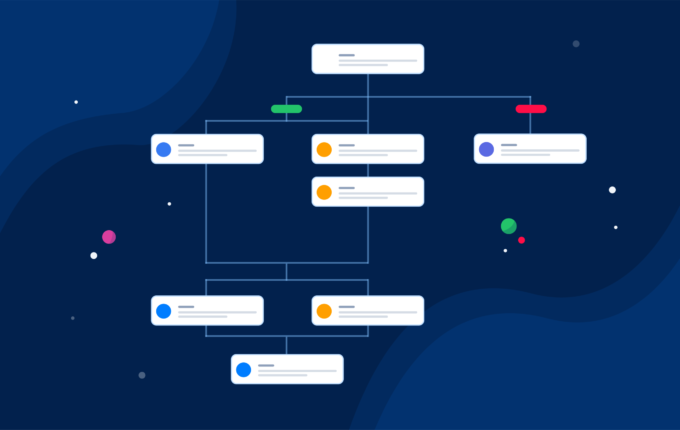Business workflows are among the best ways to improve your organization’s productivity and performance, saving you time and money in the long run. While building business workflows can be time-consuming and challenging at first, it will be worth it in the long run as you’ll also get long-term, sustainable impacts. In this article, we will look at business workflows and their benefits when implemented in your organization.
What Are Business Workflows

A business workflow is a visualized diagram (i.e., a flowchart) of a business process. On the other hand, a business process is a predefined set of tasks that are interrelated to each other to achieve the desired objective. These tasks might be sequential or non-sequential, and there are also cases where a complex series of tasks must be executed in parallel with specified requirements.
The key characteristic of a business workflow is to produce predictability: converting seemingly random and unstructured business processes into a predictable visual model, made possible with the help of a workflow builder feature in various work management tools.
A business workflow defines the start and endpoints of a business process, the steps/tasks between, the resources required to execute the tasks, what you expect for results, and so on. Also, the workflow will assign roles and responsibilities for each task. Thus, in theory, given the same input, you’ll always get the same results every time you run the same workflow. Business workflows are also critical due to the predictability; we can accurately measure the performance of each process.
Benefits of Using Business Workflows
Business workflows essentially produce transparency and predictability to your business processes. In turn, the improved predictability will provide the following benefits:
1. Improved collaboration

Optimizing your business workflows allows you to improve communications between human employees, software tools, and your company culture. Using workflow management system by Aproove, you can provide a centralized place hub where everyone can easily access information regarding the workflows and provide feedback when needed.
Also, a proper workflow system can allow integrations between different software solutions, allowing otherwise disconnected software solutions to communicate with each other. So human users can take advantage of the unified processes and tools.
2. Reducing and eliminating errors

Business workflows can enable the organization to be more proactive in identifying potential errors and prevent them from happening. While business processes with zero errors are virtually non-existent, we can reduce the risks of them happening by using workflow management systems to monitor potential issues and prevent errors from occurring in the first place. Even when errors do happen, the business workflow tool can also help you identify the exact location so you can deal with it as soon as possible.
3. Easier access to information

By providing a centralized hub of information, crucial process information may be accessed at every step, so we can quickly identify bottlenecks and redundancies. Also, with more information being made available, employees can spend their time on their core competencies rather than endlessly looking for scattered information and performing administrative duties. A workflow management system can also provide more accessible ways to track progress and measure processes’ performances.
4. Ensuring the right person is assigned the right task

Proper implementation of business workflows can allow us to assign roles and responsibilities to the right people by assessing various information. On the other hand, employees no longer need to be uncertain about who is responsible for what and can easily track other employee’s progress in the event of sequential and interdependent tasks and processes. In short, you’ll get more visibility and accountability, as we will discuss below.
5. Promoting visibility and accountability

Since the workflow management system will act as a centralized hub of information, it will improve the whole project’s visibility, which will remove obstacles for effective communications and collaborations.
Also, business workflows will automate repetitive and redundant tasks, so your team can avoid repetitive administrative tasks like sending email updates repeatedly every day and performing data entry to multiple tools.
6. Eliminates guesswork

Business workflows are executed based on predefined rules, eliminating some if not all of the guesswork typical in traditional business processes. Instead of waiting for managers or executives to make their decisions when issues arise (which often leads to actions being taken too late), business workflows will refer back to the predefined rules. In turn, this can save much time in the long run, while employees can work with confidence that the business workflows will always work as intended.
7. Automating redundant manual tasks

Repetitive tasks can cost businesses not only time but have financially cost enterprises trillions of dollars every year. By automating manual and repetitive tasks, you can let your valuable workers use their competencies on tasks that will contribute more to achieving your organizational objectives. With workflow management systems, you can automate repetitive tasks using pre-defined business rules.
8. Workflows enable audit trail

With workflow management software in place, records and data are structurally archived according to the progress and completion of business processes. You can quickly get reports regarding who completed a specific task when it was done (whether it missed the deadline), any changes/edits made, and so on.
Conclusion
Building business workflows with the help of work management software enable businesses to visualize their business processes and automate parts, if not the whole business process, while guaranteeing predictable results each time.
It’s essential, however, to find the right workflow management system according to your organization’s needs and requirements. From simple task management to workflow building and complex resources management.









